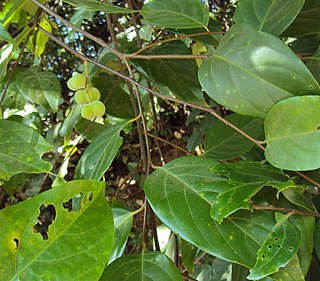
Rosaceae, the rose family, is a medium-sized family of flowering plants that includes 4,828 known species in 91 genera.
Prunus korshinskyi is a species of Prunus in the family Rosaceae. It was first discovered in Syria, and is also locally native in Turkey and southeastern Europe. It is threatened by habitat loss. It is a deciduous shrub growing to 3.5 m tall, related to the almond.
Prunus adenopoda, known locally as ki beusi is a species of plant in the family Rosaceae. It is a tree endemic to Java in Indonesia. It is an endangered species threatened by habitat loss.
Prunus arborea is a species of plant in the family Rosaceae. It is found in Indonesia, Malaysia, Singapore, and Thailand.

Prunus ceylanica is a species of plant in the family Rosaceae. It is a resident species to Sri Lanka and India.
Prunus clementis is a species of plant in the family Rosaceae. It is found in Sulawesi and the Philippines.
Prunus grisea is a species of plant in the family Rosaceae. It is found in Malaysia, the Philippines, Singapore, and Taiwan.
Prunus javanica is a species of plant in the family Rosaceae. It is found in India, Indonesia, Malaysia, and Myanmar.

Prunus kinabaluensis is a species of flowering plant in the family Rosaceae. It is found in Borneo and the Philippines.
Prunus malayana is a species of plant in the family Rosaceae. It is a tree endemic to Peninsular Malaysia.
Prunus marsupialis is a species of plant in the family Rosaceae. It is found in the Philippines and Taiwan.
Prunus polystachya, also called bat laurel, is a species of plant in the family Rosaceae. It is endemic to Singapore.
Prunus pulgarensis is a species of plant in the family Rosaceae. It is endemic to the Philippines. It is threatened by habitat loss.
Prunus rubiginosa is a species of plant in the family Rosaceae. It is endemic to the Philippines.
Prunus transarisanensis is a species of plant in the family Rosaceae. It is endemic to Taiwan. The similar species Prunus takasagomontana, also endemic to Taiwan, is thought by some authorities to be conspecific.
Prunus turfosa is a species of plant in the family Rosaceae, found in; Kalimantan, Indonesia; Sarawak, Malaysia; and possibly Brunei. The plant is restricted to peat swamp forests. As of 1998, the plant was categorised as Endangered by the IUCN on their "Red List" due to licensing of peat swamp forests of Sarawak to be logged.
Prunus walkeri is a species of plant in the family Rosaceae. It is endemic to Sri Lanka.
Prunus havardii, called Havard's wild almond or Havard's plum, is a rare North American species of shrub tree native to western Texas in the United States and to northern Chihuahua across the Río Grande in Mexico. It is in the genus Prunus in the rose family, Rosaceae.
Prunus schlechteri, aimangelo, is a species of Prunus native to New Guinea and the Solomon Islands. It is a tree reaching 35 m. Native peoples chew a pulp of its bark to alleviate the pain of toothaches or apply it externally to relieve aching muscles.
Prunus glabrifolia is a species of Prunus native to Malaya, Sumatra and Sarawak. It is a shrub or small tree reaching 15 m. It is morphologically somewhat similar to Prunus grisea var. tomentosa, but can be easily distinguished by its much stiffer leaves.



